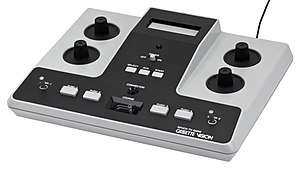Cassette Vision
The Cassette Vision (Japanese: カセットビジョン, Hepburn: Kasetto Bijon) is a home video game console made by Epoch Co. and released in Japan on July 30, 1981. There is also a redesigned model called the Cassette Vision Jr.
 A Cassette Vision | |
| Manufacturer | Epoch Co. |
|---|---|
| Type | Home video game console |
| Generation | Second generation |
| Release date | |
| Introductory price | ¥13,500 |
| Units sold | Ca. 400,000[2] |
| CPU | NEC uPD77xx |
| Removable storage | ROM cartridge |
| Input | Internal controllers |
| Predecessor | TV Vader |
| Successor | Super Cassette Vision |
The term cassette is a contemporary Japanese synonym for ROM cartridge, not to be confused with the magnetic cassette tape format. In terms of power, it is comparable to the Atari 2600. The Cassette Vision has unusual controls: four knobs built into the console itself, two for each player (one for horizontal, one for vertical); plus two buttons per player.
The system originally retailed for 13,500 yen, with games priced at 4,000. The Cassette Vision sold around 400,000 units, and was the best selling video game console in Japan before Nintendo's Family Computer.[3] It received a successor called the Super Cassette Vision. As a 1984 machine, the Super Cassette Vision was more comparable to the likes of the Famicom and Sega's SG-1000 line. The SCV was also sold in Europe, but with little known success.[4] The Super Lady Cassette Vision, a version of the Super Cassette Vision that was aimed at a female market, was released exclusively in Japan. While the specs were exactly the same, the plastic was pink in color and included a carrying case and the "Milky Princess" game.
Games
- 1. Kikori no Yosaku
- 2. Baseball – a baseball game released by Epoch in 1981 (This game was playable before it came out for the Cassette Vision with the 1978 dedicated console TV Baseball.)
- 3. Galaxian (This is not based on Namco's game but on Nihon Bussan's Moon Cresta)
- 4. Big Sports 12 – a sports game released by Epoch in 1981.
- 5. Battle Vader – a shoot 'em up released by Epoch in 1982. (This game was playable two years before it came out for the Cassette Vision with the 1980 dedicated console TV Vader.)
- 6. PakPak Monster (Inspired by Pac-Man)
- 7. New Baseball
- 8. Monster Mansion (Inspired by Donkey Kong)
- 9. Astro Command – an action game released by Epoch in 1983. (Inspired by Scramble)
- 11. Monster Block (Inspired by Pengo)
- 12. Elevator Panic
Accessory
In the same as the launch of the Cassette Vision, Epoch released a Light Gun to go with the Big Sport 12 games. The cartridge contains a collection of 12 games, including 4 that required the use of the light gun. The gun connects to the console via the AUX connector. This is the only accessory available for the Cassette Vision and therefore the only peripheral that use the AUX connection. This connector was later removed when Epoch released the Cassette Vision Jr, a trim down version of the Cassette Vision, making the Gun incompatible with that version of the console.
Technical specifications

Cassette Vision's controllers are integrated into the body.
|
|
Epoch decided to capitalize on the NEC uPD77xx chipset as they had already used to develop games on this platform (TV Baseball, TV Vader). To achieve this, Epoch decided to put the CPU directly in the cartridge while the shell of the console would only contain the power supply, the controls and the video and sound output. Having the ROM, the RAM and the CPU in one chip, Epoch/NEC were able to create a chip that would support 48 bits instruction which was way faster than systems using a separate ROM at the time. Using 8-bit ROM though a BUS would have divided the speed by 4. Although having only the ROM on the cartridge would have reduced their cost drastically, it would have greatly increased the cost of the console itself, incur more R&D cost and delay the release of the console.
References
- "Release Date". Retrieved 2013-10-06.
- "株式会社 エポツク杜 堀江正幸氏 (pg. 9)" (in Japanese). 1998. Retrieved August 29, 2017.
- "株式会社 エポツク杜 堀江正幸氏 (pg. 9)" (in Japanese). 1998. Retrieved August 29, 2017.
- "Epoch Super Cassette Vision: History & Reviews". Video Game Console Library. Retrieved August 29, 2017.
| Wikimedia Commons has media related to Epoch Cassette Vision. |
